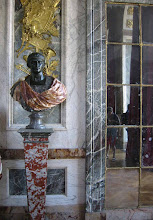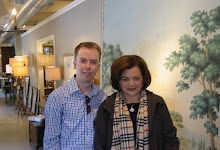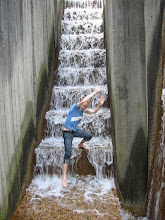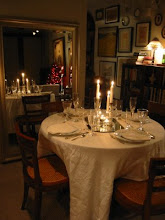
This weekend I visited
Cliveden, the Benjamin Chew House, outside of Philadelphia with
JCB,
Pigtowndesign and other friends. Cliveden is a magnificent Georgian House from 1763 that was intimately involved with the revolutionary war: The Battle of Germantown was literally fought within its' walls!

The large grounds are parklike but the neighorhood of beautiful stone houses has encroached closer and closer to where it feels more like the large lot in a city neighborhood it currently is.

However, when it was built- this was the family's country seat and like many houses of the day was modeled on the country homes of Britain.

The stone was quarried on site (now a few blocks away) and has an imposing finished stone front with the sides of rough stone (24" thick!!) covered in scored cement to look like stone.

Over the years parts of the stucco-like finish have worn away revealing the rough stone work. I love this texture! The revolutionary war no doubt had a lot to do with this as the family kept many of the battle wounds received from the battle of Germantown.

The battle was even fought IN the house as British soldiers barricated themselves within, using it as a fortress. The home was not occupied before the battle of Germantown despite the occupation of Philadelphia because of the lion statues at the front door: a common symbol of a loyalist.

During the battle, the home was badly damaged, as commemorated in this painting in the entryway, seen below. The family sold the house rather than pay to restore it, but managed to buy it back at pennies on the dollar 22 years later.

The house stayed within the Chew family until 1972 when it was turned into a house museum. It is now operated by the
National Trust for Historic Preservation.

Lets go inside. The front door opens into a spacious entryway, above you see the shutter-like screen doors.

The woodwork is amazing throughout the house, particularly in the entryway. Above is a doorway into the master's study.

The entry into the stairhall, above, is really beautiful and grand.

Above we are peaking through the grand entry into the stairhall.

The window surrounds even have beautiful woodwork. Who wants draperies when they would hide all of this! One of the reasons I feel the house resonated with me was the lack of fussiness but still a lot of gorgeous detailing.

The masters study has these beautiful built-in bookcases with some of Benjamin Chew's original leather bound books.

On the other side of the entry hall is the entrance into the mistresses office.

It does not have the bookcases like the master's study but has this beautiful yellow damask covered chair beside the corner fireplace which contrasted nicely with the french gray painted woodwork.

The stairhall was as impressive as the entryhall. Above we are looking towards the entry. The doorway on your right goes into the dining room while to the left is entry into the Parlor.

The generous size of the stairhall makes the entire house feel larger than it actually is. An addition from the 1870s is seen behind here.

The designer cleverly concealed any knowledge of the addition by detailing the door like a window using mirror. When it is closed, it appears as a window above wainscoting.

The parlor was one of the most elegant rooms I have ever been in (as is the whole house!). A yellow silk damask sofa sits with card tables and some of the most spectacular mirrors!

This one was really unusual. I love the contrast with the rough plaster wall behind. The house is currently undergoing repairs (and we weren't able to tour the 2nd floor).

2 other identical mirrors, one seen above, line the room. As candles were a luxury, these mirrors would reflect the candlelight in the evenings.

The fireplace has some beautiful chinese porcelain, a marble surround and more beautiful painted wood carving.

Part of the restorations are to work on the walls flanking the fireplace and restore original mouldings that had been removed over the course of time. This drawing (which hopefully you can see thanks to photoshop) shows the fake 'doorways' which will flank the fireplace.

The dining room on the other side of the stairhall is set up to match a 1963 Vogue magazine article about the lady of the manor. Interestingly enough, the vogue editor interviewed Mrs. Chew the day Kennedy was assasinated.

Gas and heat were introduced into the house in the 1870s (at the request of the owner's children) and here you can see the original heating grate on the floor of the stairhall. Totally obvious but still beautiful! I hope you have enjoyed the house as much as I did. I will post about the other earlier Georgian house we toured,
Stenton, later this week.
 This weekend I visited Cliveden, the Benjamin Chew House, outside of Philadelphia with JCB, Pigtowndesign and other friends. Cliveden is a magnificent Georgian House from 1763 that was intimately involved with the revolutionary war: The Battle of Germantown was literally fought within its' walls!
This weekend I visited Cliveden, the Benjamin Chew House, outside of Philadelphia with JCB, Pigtowndesign and other friends. Cliveden is a magnificent Georgian House from 1763 that was intimately involved with the revolutionary war: The Battle of Germantown was literally fought within its' walls! The large grounds are parklike but the neighorhood of beautiful stone houses has encroached closer and closer to where it feels more like the large lot in a city neighborhood it currently is.
The large grounds are parklike but the neighorhood of beautiful stone houses has encroached closer and closer to where it feels more like the large lot in a city neighborhood it currently is. However, when it was built- this was the family's country seat and like many houses of the day was modeled on the country homes of Britain.
However, when it was built- this was the family's country seat and like many houses of the day was modeled on the country homes of Britain. The stone was quarried on site (now a few blocks away) and has an imposing finished stone front with the sides of rough stone (24" thick!!) covered in scored cement to look like stone.
The stone was quarried on site (now a few blocks away) and has an imposing finished stone front with the sides of rough stone (24" thick!!) covered in scored cement to look like stone.  Over the years parts of the stucco-like finish have worn away revealing the rough stone work. I love this texture! The revolutionary war no doubt had a lot to do with this as the family kept many of the battle wounds received from the battle of Germantown.
Over the years parts of the stucco-like finish have worn away revealing the rough stone work. I love this texture! The revolutionary war no doubt had a lot to do with this as the family kept many of the battle wounds received from the battle of Germantown. The battle was even fought IN the house as British soldiers barricated themselves within, using it as a fortress. The home was not occupied before the battle of Germantown despite the occupation of Philadelphia because of the lion statues at the front door: a common symbol of a loyalist.
The battle was even fought IN the house as British soldiers barricated themselves within, using it as a fortress. The home was not occupied before the battle of Germantown despite the occupation of Philadelphia because of the lion statues at the front door: a common symbol of a loyalist. During the battle, the home was badly damaged, as commemorated in this painting in the entryway, seen below. The family sold the house rather than pay to restore it, but managed to buy it back at pennies on the dollar 22 years later.
During the battle, the home was badly damaged, as commemorated in this painting in the entryway, seen below. The family sold the house rather than pay to restore it, but managed to buy it back at pennies on the dollar 22 years later.  The house stayed within the Chew family until 1972 when it was turned into a house museum. It is now operated by the National Trust for Historic Preservation.
The house stayed within the Chew family until 1972 when it was turned into a house museum. It is now operated by the National Trust for Historic Preservation. Lets go inside. The front door opens into a spacious entryway, above you see the shutter-like screen doors.
Lets go inside. The front door opens into a spacious entryway, above you see the shutter-like screen doors.  The woodwork is amazing throughout the house, particularly in the entryway. Above is a doorway into the master's study.
The woodwork is amazing throughout the house, particularly in the entryway. Above is a doorway into the master's study. The entry into the stairhall, above, is really beautiful and grand.
The entry into the stairhall, above, is really beautiful and grand. Above we are peaking through the grand entry into the stairhall.
Above we are peaking through the grand entry into the stairhall. The window surrounds even have beautiful woodwork. Who wants draperies when they would hide all of this! One of the reasons I feel the house resonated with me was the lack of fussiness but still a lot of gorgeous detailing.
The window surrounds even have beautiful woodwork. Who wants draperies when they would hide all of this! One of the reasons I feel the house resonated with me was the lack of fussiness but still a lot of gorgeous detailing. The masters study has these beautiful built-in bookcases with some of Benjamin Chew's original leather bound books.
The masters study has these beautiful built-in bookcases with some of Benjamin Chew's original leather bound books. On the other side of the entry hall is the entrance into the mistresses office.
On the other side of the entry hall is the entrance into the mistresses office. It does not have the bookcases like the master's study but has this beautiful yellow damask covered chair beside the corner fireplace which contrasted nicely with the french gray painted woodwork.
It does not have the bookcases like the master's study but has this beautiful yellow damask covered chair beside the corner fireplace which contrasted nicely with the french gray painted woodwork. The stairhall was as impressive as the entryhall. Above we are looking towards the entry. The doorway on your right goes into the dining room while to the left is entry into the Parlor.
The stairhall was as impressive as the entryhall. Above we are looking towards the entry. The doorway on your right goes into the dining room while to the left is entry into the Parlor. The generous size of the stairhall makes the entire house feel larger than it actually is. An addition from the 1870s is seen behind here.
The generous size of the stairhall makes the entire house feel larger than it actually is. An addition from the 1870s is seen behind here. The designer cleverly concealed any knowledge of the addition by detailing the door like a window using mirror. When it is closed, it appears as a window above wainscoting.
The designer cleverly concealed any knowledge of the addition by detailing the door like a window using mirror. When it is closed, it appears as a window above wainscoting. The parlor was one of the most elegant rooms I have ever been in (as is the whole house!). A yellow silk damask sofa sits with card tables and some of the most spectacular mirrors!
The parlor was one of the most elegant rooms I have ever been in (as is the whole house!). A yellow silk damask sofa sits with card tables and some of the most spectacular mirrors! This one was really unusual. I love the contrast with the rough plaster wall behind. The house is currently undergoing repairs (and we weren't able to tour the 2nd floor).
This one was really unusual. I love the contrast with the rough plaster wall behind. The house is currently undergoing repairs (and we weren't able to tour the 2nd floor).  2 other identical mirrors, one seen above, line the room. As candles were a luxury, these mirrors would reflect the candlelight in the evenings.
2 other identical mirrors, one seen above, line the room. As candles were a luxury, these mirrors would reflect the candlelight in the evenings. The fireplace has some beautiful chinese porcelain, a marble surround and more beautiful painted wood carving.
The fireplace has some beautiful chinese porcelain, a marble surround and more beautiful painted wood carving. Part of the restorations are to work on the walls flanking the fireplace and restore original mouldings that had been removed over the course of time. This drawing (which hopefully you can see thanks to photoshop) shows the fake 'doorways' which will flank the fireplace.
Part of the restorations are to work on the walls flanking the fireplace and restore original mouldings that had been removed over the course of time. This drawing (which hopefully you can see thanks to photoshop) shows the fake 'doorways' which will flank the fireplace. The dining room on the other side of the stairhall is set up to match a 1963 Vogue magazine article about the lady of the manor. Interestingly enough, the vogue editor interviewed Mrs. Chew the day Kennedy was assasinated.
The dining room on the other side of the stairhall is set up to match a 1963 Vogue magazine article about the lady of the manor. Interestingly enough, the vogue editor interviewed Mrs. Chew the day Kennedy was assasinated. Gas and heat were introduced into the house in the 1870s (at the request of the owner's children) and here you can see the original heating grate on the floor of the stairhall. Totally obvious but still beautiful! I hope you have enjoyed the house as much as I did. I will post about the other earlier Georgian house we toured, Stenton, later this week.
Gas and heat were introduced into the house in the 1870s (at the request of the owner's children) and here you can see the original heating grate on the floor of the stairhall. Totally obvious but still beautiful! I hope you have enjoyed the house as much as I did. I will post about the other earlier Georgian house we toured, Stenton, later this week.





















.jpg)





















.JPG)







































































13 comments:
Haha! Just posting Stenton. All of my pix are dark, too!
Thanks so much, the dark doesn't take away an ounce of the houses dignity. They just don't do roof urns like they used to.
It was dark, but I like to think it adds to the atmosphere - that may be one of the reasons I really fell in love with the house! Unfortunately -it also means some of the details are lost in the photographs, but thats an easy trade for atmosphere.
A beautiful house, but somehow it seems lonely and depressed? Not just the darkness, but a starkness. A house such as this should speak of merriment.
Lize, a bit -but I think another reason for that is it is a museum and not a family house. It is set up more for historical reference as opposed to as a family home or how it was lived in neccesarily. I found the starkness beautiful.
The house is amazing, but I particularly enjoyed your photography. Terrific!
Thanks, Patricia! I hope they turned out ok in the dark and that my love of this house shines through!
Stefan...it looks great! My photographs of Cliveden are not nearly as good (or as plentiful ~ I think I got tired).
Thanks Janet! I think the yummy lunch (not to mention the crazy beautiful house) revived me! I'm not sure how you were able to function for a black tie event that night!
Gorgeous that house is beautiful. I love all of those architectural details.
I thoroughly enjoyed this tour, and the front elevation made me appreciate the purity of form in classic architecture. Hundreds of years later, and this house looks just as beautiful to the eye of the 21st century as it did to the eye of the 18th. Amazing.
Great shots of the millwork and architectual details throughout! As an interior designer who specializes in interior architecture finish out in new construction, I always reference some form of the past. Thanks for taking notice of the details that makes a home complete!
Love the exterior of this historic home. Always imagined having a country house like this one day! One day...!
Coco
Cococozy
http://www.cococozy.com
Post a Comment